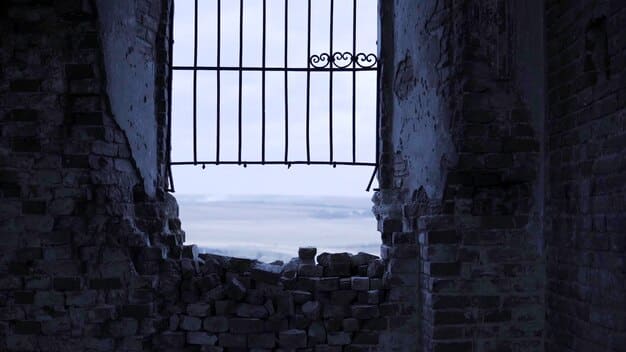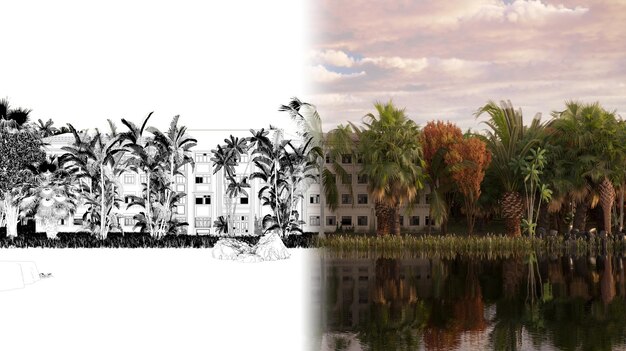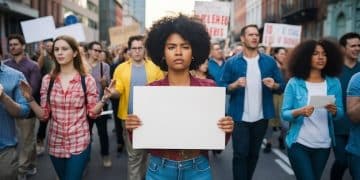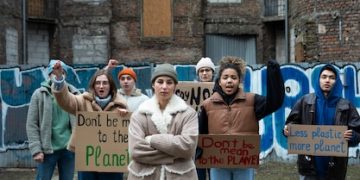How Does the Prison Industrial Complex Fuel Social Injustice? A 2025 Examination

In 2025, the prison industrial complex continues to perpetuate social injustice by disproportionately affecting marginalized communities, incentivizing mass incarceration, and creating economic dependencies on imprisonment, thereby undermining rehabilitation and reinforcing systemic inequalities.
The prison industrial complex perpetuate social injustice? A 2025 examination reveals a system deeply entrenched in economic and political structures that exacerbate existing inequalities.
Understanding the Prison Industrial Complex
The prison industrial complex (PIC) is a term that describes the multi-billion dollar industry that profits from incarceration. Understanding its mechanics is crucial to grasping how it perpetuates social injustice.
Defining the Prison Industrial Complex
The PIC encompasses private prison companies, construction firms, vendors providing goods and services to prisons, and even government agencies that benefit from increased incarceration rates. Its economic incentives often clash with the goals of rehabilitation and justice.
Historical Roots of the PIC
The PIC did not emerge overnight. Its origins can be traced back to the post-Civil War era, with the convict leasing system that exploited formerly enslaved people, laying the groundwork for modern mass incarceration.

Here are some key aspects that contribute to the prison industrial complex:
- Lobbying efforts to pass stricter sentencing laws that increase prison populations.
- Contracts with private companies that guarantee occupancy rates, incentivizing imprisonment regardless of crime rates.
- Exploitation of inmate labor for low wages, providing cheap labor for corporations.
- Political contributions to influence criminal justice policies.
By understanding these foundational aspects, we can start to see how the PIC became intertwined with social injustice. This sets the stage for a more nuanced examination of its impacts.
How the PIC Disproportionately Impacts Marginalized Communities
The PIC does not affect all communities equally. It disproportionately targets and harms marginalized groups, including people of color, low-income individuals, and those with mental health issues.
Racial Disparities in Incarceration
Data consistently shows that Black and Brown individuals are incarcerated at rates far higher than their White counterparts. This disparity reflects systemic biases within the criminal justice system, from policing practices to sentencing guidelines.
Economic Factors and Incarceration
Poverty and lack of economic opportunity are significant drivers of involvement in the criminal justice system. Individuals from low-income backgrounds often face limited access to education, employment, and legal resources, making them more vulnerable to incarceration.
Mental Health and the PIC
Many individuals in prison suffer from mental health issues that are often exacerbated by the harsh conditions of incarceration. The lack of adequate mental health care within prisons further perpetuates a cycle of recidivism.

Several factors contribute to this disproportionate impact:
- Discriminatory policing practices that target communities of color.
- Biased sentencing policies that impose harsher penalties on certain groups.
- Lack of investment in communities, leading to increased crime rates.
- Inadequate access to mental health and substance abuse treatment.
The PIC not only reinforces existing social inequalities but also creates new ones, contributing to a vicious cycle of disadvantage. Understanding these impacts is crucial for advocating for systemic change.
The Economic Incentives of Mass Incarceration
One of the most troubling aspects of the PIC is its reliance on economic incentives that prioritize profit over justice. This creates a system where more people in prison means more money for those who benefit from incarceration.
Private Prisons and Profit Motives
Private prison companies are driven by the need to generate profits for their shareholders. This often leads to lobbying for policies that increase prison populations, such as stricter sentencing laws and mandatory minimums.
Vendor Contracts and Service Agreements
Numerous vendors provide goods and services to prisons, ranging from food and medical care to security equipment and transportation. These contracts can be lucrative, incentivizing vendors to maintain or expand their business with correctional facilities.
Inmate Labor and Cheap Workforce
Inmate labor is often exploited by both private companies and government agencies. Inmates are paid minimal wages for their work, providing a cheap workforce that undermines fair labor practices and perpetuates economic exploitation.
Key elements of these economic incentives include:
- Occupancy guarantees in contracts with private prison companies, ensuring a steady stream of revenue.
- Lobbying efforts to maintain or increase funding for correctional facilities.
- Exploitation of inmate labor to reduce labor costs for businesses.
By examining these incentives, it becomes clear that the PIC is not simply a system of punishment but also a complex economic enterprise. This understanding is essential for advocating for reforms that prioritize justice over profit.
The Role of Legislation and Policy in Perpetuating Injustice
Legislation and policy play a significant role in shaping the landscape of the PIC. Laws and policies that promote mass incarceration and exacerbate social inequalities must be critically examined and reformed.
Three Strikes Laws and Mandatory Minimums
Three strikes laws and mandatory minimum sentencing policies have contributed to skyrocketing prison populations by imposing lengthy sentences for even minor offenses. These policies often lack nuance and disproportionately affect marginalized communities.
Drug War Policies and Incarceration Rates
The War on Drugs has led to the mass incarceration of individuals for drug-related offenses, particularly in communities of color. These policies have had devastating consequences for families and communities, while doing little to address the root causes of drug abuse.
Criminal Justice Reform Efforts
Despite the challenges, there are ongoing efforts to reform the criminal justice system and address the injustices perpetuated by the PIC. These efforts include advocating for sentencing reform, investing in community-based alternatives to incarceration, and promoting restorative justice practices.
Legislative and policy changes can have several positive impacts:
- Reducing the number of people incarcerated for non-violent offenses.
- Investing in rehabilitation and re-entry programs.
- Addressing systemic biases in the criminal justice system.
Reforming the PIC requires a multi-faceted approach that addresses both the economic and legislative aspects of mass incarceration. By advocating for policy changes that prioritize justice and rehabilitation, we can work towards a more equitable and humane system.
The Social and Psychological Impacts of Incarceration
Incarceration has profound social and psychological impacts on individuals, families, and communities. These impacts extend far beyond the walls of the prison, perpetuating cycles of trauma and disadvantage.
Impact on Families and Communities
When individuals are incarcerated, it can have devastating consequences for their families and communities. Children with incarcerated parents are more likely to experience poverty, trauma, and involvement in the criminal justice system themselves.
Mental Health Consequences of Incarceration
The harsh conditions of incarceration can exacerbate existing mental health issues and lead to new ones. Inmates often experience isolation, trauma, and a lack of access to mental health care, contributing to long-term psychological harm.
Challenges of Re-entry and Recidivism
Individuals who are released from prison often face significant challenges in re-entering society, including difficulty finding employment, securing housing, and accessing social services. These challenges can increase the likelihood of recidivism, perpetuating a cycle of incarceration.
Here are some ways incarceration affects individuals and communities:
- Reduced economic opportunities due to criminal records.
- Increased rates of poverty and family instability.
- Higher rates of mental health issues and substance abuse.
Addressing the social and psychological impacts of incarceration requires a comprehensive approach that includes providing support for families, improving access to mental health care, and investing in re-entry programs that help individuals successfully transition back into society.
Alternatives to Incarceration and Community-Based Solutions
Reducing reliance on incarceration requires exploring and implementing alternatives to traditional imprisonment. Community-based solutions that address the root causes of crime and promote rehabilitation are essential for creating a more just and equitable society.
Restorative Justice Practices
Restorative justice focuses on repairing the harm caused by crime and involving all stakeholders in the process, including victims, offenders, and community members. It emphasizes accountability, healing, and reconciliation.
Community-Based Rehabilitation Programs
Community-based rehabilitation programs provide individuals with the support and resources they need to address the underlying issues that contribute to their involvement in the criminal justice system, such as substance abuse, mental health issues, and lack of education or employment opportunities.
Investing in Education and Economic Opportunity
Investing in education and economic opportunity can help prevent crime by providing individuals with the skills and resources they need to succeed in life. This includes access to quality education, job training programs, and affordable housing.
Effective alternatives to incarceration include:
- Drug treatment programs that address addiction rather than punishment.
- Mental health services that provide support and treatment for individuals in need.
- Job training programs that help individuals develop marketable skills.
By investing in these alternatives, we can reduce reliance on incarceration and create safer, healthier communities. This shift towards community-based solutions is crucial for dismantling the PIC and building a more just and equitable society.
| Key Point | Brief Description |
|---|---|
| 💰 Economic Incentives | Profits drive mass incarceration, influencing policies & prison expansion. |
| ✊ Disproportionate Impact | Marginalized communities, especially people of color, are unfairly targeted. |
| 🌱 Community Solutions | Alternatives like restorative justice and rehabilitation offer better outcomes. |
| ⚖️ Policy Changes | Reforming laws to reduce incarceration rates and address systemic biases. |
FAQ
▼
The prison industrial complex is a term describing the network of corporations, government agencies, and political interests that profit from incarceration. It includes private prisons, vendors, and lobbyists.
▼
The PIC disproportionately impacts marginalized communities by targeting people of color and low-income individuals. This results in higher incarceration rates, straining families and communities.
▼
Economic incentives include profit from private prisons, vendor contracts, and cheap inmate labor. These drive policies that increase incarceration for financial gain, promoting injustice.
▼
Alternatives include restorative justice, community-based rehabilitation, and drug treatment programs. These aim to address the root causes of crime and reduce recidivism.
▼
Yes, policy changes can reform the system by reducing mandatory minimums, reinvesting in communities, and addressing biases. This supports a more just and equitable criminal justice system.
Conclusion
As we examine the prison industrial complex in 2025, it’s evident that systemic changes are crucial to addressing the social injustices it perpetuates. By focusing on community solutions, policy reforms, and addressing the economic incentives, we can move towards a more equitable and just society for all.





